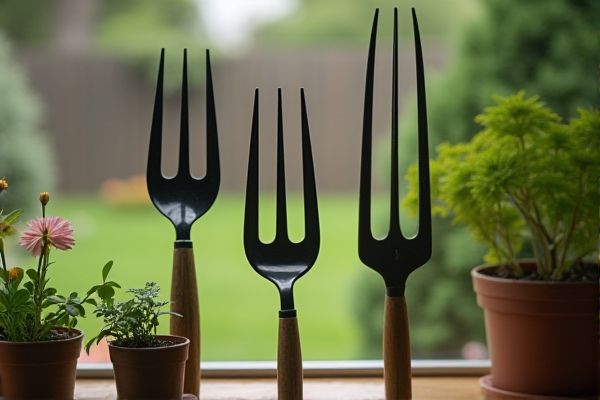
A garden fork is a handheld tool with narrow, sturdy tines designed for digging and turning soil in compact areas, while a broadfork features wider, longer tines and handles, making it ideal for loosening larger sections of soil without disturbing its structure. Discover which tool best suits Your gardening needs by continuing to explore the key differences and uses in this article.
Table of Comparison
| Feature | Garden Fork | Broadfork |
|---|---|---|
| Purpose | Loosening soil in small garden beds | Loosening and aerating large garden beds without turning soil |
| Design | Single-handled tool with 4-5 metal tines | Two-handled tool with 6-12 tines across a wide frame |
| Soil Impact | Penetrates and turns soil | Loosens soil layers, preserving soil structure |
| Usage | Digging, aerating, removing weeds | Breaking up compacted soil in larger areas |
| Effort Required | Moderate; requires spade-like digging force | Lower; lever action reduces physical strain |
| Best For | Small-scale gardens, tight spaces | Large garden beds, no-till gardening |
| Material | Steel tines, wooden or metal handle | Steel tines, sturdy wooden or metal frame |
Introduction: Garden Fork vs Broadfork
A garden fork features sturdy tines designed for digging and turning soil in tight spaces, making it ideal for smaller garden beds. A broadfork has wider, longer tines that loosen soil deeply without turning it, preserving soil structure and promoting aeration on larger plots. Choosing between a garden fork vs broadfork depends on your garden size and soil management goals.
What is a Garden Fork?
A garden fork is a versatile hand tool with sturdy, short tines designed for digging, turning, and aerating soil in garden beds. It excels at breaking up compacted soil and lifting root crops without causing excessive damage. Your choice between a garden fork and a broadfork depends on the depth and scale of soil cultivation needed.
What is a Broadfork?
A broadfork is a manual gardening tool designed to aerate and loosen soil deeply without disturbing soil structure or harming beneficial organisms. Unlike a garden fork, which has fewer tines and is used for turning soil or digging, a broadfork typically has multiple long, evenly spaced tines mounted on a wide horizontal bar for efficient soil penetration. Your choice between these tools depends on the scale of soil preparation and the specific cultivation method you prefer.
Design Differences
A garden fork features a single handle with a set of typically four to six tapered tines designed for digging and aerating soil in smaller areas or raised beds. A broadfork, on the other hand, has two handles and a wider, horizontal bar with more robust tines, allowing you to loosen larger sections of soil without disturbing the soil structure significantly. Your choice between these tools depends on the size of the area you need to work and the level of soil disturbance required.
Soil Preparation Efficiency
A garden fork offers efficient soil preparation by breaking up compacted soil and allowing better aeration with its sturdy, narrow tines ideal for smaller beds. A broadfork provides superior soil preparation efficiency across larger areas, loosening soil deeply without disturbing its structure, promoting optimal root growth and moisture retention. Choosing the right tool enhances your soil management, improving plant health and garden productivity.
Ease of Use and Ergonomics
A garden fork offers straightforward handling, making it suitable for smaller tasks with a comfortable grip and manageable weight. A broadfork, designed for aerating larger garden beds, has longer tines and two handles allowing you to apply leverage more efficiently, reducing strain during use. Choosing between the two depends on your garden size and physical comfort needs during prolonged soil cultivation.
Best Applications for Each Tool
A garden fork excels in breaking up compacted soil and turning compost, offering precise control for smaller beds and dense or root-bound areas. Broadforks are ideal for aerating large garden plots and no-till farming, loosening deeper soil layers without disturbing soil structure. Choosing between these tools depends on soil condition and the scale of your gardening project.
Pros and Cons Comparison
Garden forks provide excellent leverage for turning heavy, compacted soil and are easier to maneuver in tight spaces, but they can cause more soil disturbance and are less efficient at aerating large garden beds. Broadforks cover a wider area per pass, promoting soil aeration and preserving soil structure by minimizing disturbance, though they require more physical effort and are less effective in rocky or root-dense soils. Choosing between these tools depends on garden size, soil condition, and user strength, with garden forks suited for smaller, compacted areas and broadforks ideal for extensive, loosening tasks.
Choosing the Right Tool for Your Garden
Selecting between a garden fork and a broadfork depends on the specific gardening tasks and soil conditions; garden forks are ideal for turning and loosening heavy, compacted soil in smaller areas, while broadforks excel at aerating and loosening large beds without disrupting soil structure. Garden forks typically have four sturdy tines and are used for digging, compost turning, and breaking up clumps of soil, making them perfect for tasks requiring precision and control. Broadforks feature two long handles and multiple tines spread across a wide area, allowing gardeners to break up deep soil layers effectively while preserving soil integrity, which is essential for maintaining healthy root systems and improving drainage.
Conclusion: Which Tool is Right for You?
A garden fork excels at digging, turning soil, and breaking up compacted dirt with its narrow, strong tines, making it ideal for smaller or tougher tasks. A broadfork, designed with wide, flat tines and a sturdy crossbar, provides efficient aeration and soil loosening without disturbing soil layers, perfect for larger garden beds and preserving soil structure. Your choice should depend on your specific gardening needs: use a garden fork for heavy-duty digging and a broadfork for gentle soil aeration and preparation.
 homyna.com
homyna.com